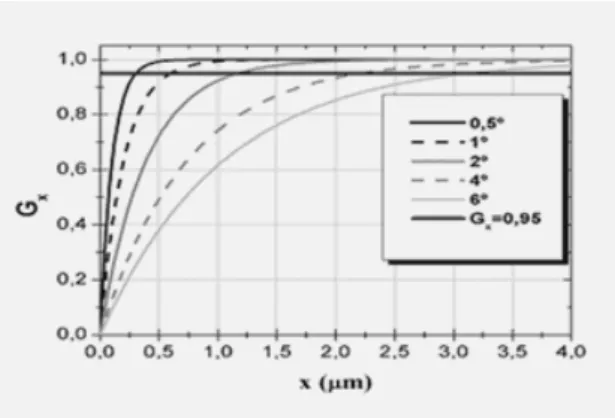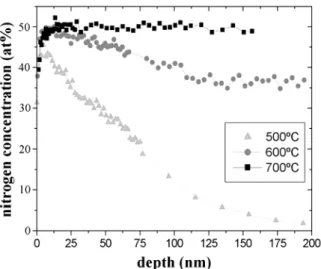ISSN 1 5 1 7 - 7 0 7 6
Revista Matéria, v. 15, n. 2, pp. 299-302, 2010. http://www.materia.coppe.ufrj.br/sarra/artigos/artigo11232
Autor Responsável: Marcos Antonio Zen Vasconcellos Data de envio: 20/03/2010 Data de aceite: 30/06/2010
Hardness evaluation, stoichiometry and grain size of titanium nitride
films obtained with plasma nitriding on Ti-6Al-4V samples
Marcos Antonio Zen VasconcellosI; Saulo Cordeiro LimaI; Ruth HinrichsII
I
Physics Department, Universidade Federal do Rio Grande do Sul, Porto Alegre, Brazil e-mail: marcos@if.ufrgs.br
II
Geology Department, Universidade Federal do Rio Grande do Sul, Porto Alegre, Brazil e-mail: ruth.hinrichs@ufrgs.br
ABSTRACT
Titanium nitride films were formed on the surface of Ti-6Al-4V discs by plasma nitriding (glow discharge) in different N2:H2 atmospheres at several substrate temperatures. In this study the influence of the
process parameters on dynamic micro-hardness were investigated. Grain sizes of the nitride films, determined with X-Ray Diffraction, were related to the nitriding parameters. TiNx stoichiometry was determined with Nuclear Reaction Analysis and showed a correlation to substrate temperature during the nitriding process. Micro-hardness measurements were taken on the nitrided surfaces. Grain sizes increased for a particular gas composition of 60%N2+40%H2 where hardness was lowest.
Keywords: Glow discharge, nitride, hardness
1 INTRODUCTION
The application of titanium alloys is limited by low shear strength, high coefficient of friction, low hardness and poor wear resistance. Plasma nitriding by glow discharge is an important process to improve surface properties of these alloys [1-6]. Some questions remain about the dependence of surface properties on nitriding parameters. This work presents influence of the process parameters on surface modifications obtained on Ti-6Al-4V: dynamic micro-hardness, grain sizes from X-Ray Diffraction and TiNx stoichiometry from Nuclear Reaction Analysis (NRA) were determined and related to deposition temperature and gas composition. Micro-hardness measurements on the nitrided surfaces varied significantly due to the inherent asperity of the films and showed a weak inverse correlation to grain size of the surface film.
2 MATERIALS AND METHODS
Ti-6Al-4V samples were nitrided at temperatures of 500, 600 and 700 °C and gas mixtures of 80%N2+20%H2, 60%N2+40%H2, 50%N2+50%H2, 40%N2+60%H2, and 20%N2+80%H2.
Phases formed on the surface were characterized using Glancing Incidence X-ray Diffraction (GIXRD) with incidence angles of 0.5°, 1°, 2° , 4° and 6°, using a XRD6000 from Shimadzu with a thin film attachment. This technique probes different depths of the sample surface [7], following the equation
[1/ ( ) 1/ (2 )]
1
x sen senx
G
= −
e
−μ α + θ−α (1)Where Gx is the fraction of the diffraction intensity coming from a certain depth, μ is the x-ray
absorption coefficient, x is depth, α is the incidence angle and θ is the scattering angle. Depths probed by different incidence angles in TiN (μTiN = 8,49 x 10-2 μm
-1
) are shown on Figure 1. The significant peak fraction is considered to be 95%.
Nitrogen content of the near surface layer (200 nm) was obtained with Nuclear Reaction Analysis (NRA), where the samples were irradiated with 429 keV protons using a HVEE-500 kV linear accelerator. The gamma rays produced in the nuclear reaction 15N(p,αγ)12C were counted to quantify nitrogen content.
VASCONCELLOS, M.A.Z., LIMA, S.C., HINRICHS, R.; Revista Matéria, v. 15, n. 2, pp. 399-302, 2010.
Figure 1: Depth of significant fraction (horizontal line, 95%) of diffraction peaks in TiN. Different incidence angles are indicated.
3 RESULTS AND DISCUSSION
Figure 2 shows a set of diffraction patterns at incidence angles of 0.5°, 1°, 2°, 4° and 6° from a sample nitrided at 700 °C in a gas mixture of 80%N2+20%H2. The most intense peaks in these diffractograms
are related to -TiN (labeled δ in the graph), and reach maximum value at 2°. The phase -Ti2N is observed at
all incidence angles and reaches maximum values at 4°. This difference in relative intensities of the two nitrides evidences a layered structure, with -TiN on top of -Ti2N. Peaks from α-Ti are not visible at
incidence angles below 4° indicating that the titanium alloy is below the other two phases at a depth of almost 2 μm.
Figure 2: Diffraction patterns with incidence angles of 0.5°, 1°, 2°, 4°and 6° from a sample nitrided at 700 °C in 80% N2 + 20% H2 . δ, ε and α refer to -TiN, -Ti2N, and α-Ti, respectively.
NRA results (Figure 3) also show the formation of phases with distinct composition, as indicated by the presence of plateaus in the depth profile at compositions that are compatible with the stoichiometry of the phases δ-TiN and ε-Ti2N.
For all samples the formation of titanium nitride with approximately 50 at% of nitrogen was observed near the surface. The 700 °C sample showed this value at all depths analyzed (200 nm). The 600 °C sample showed a 50 nm TiN plateau, then a region with a decreasing diffusional profile until 100 nm, where a plateau corresponding to ε-Ti2N appeared, with nitrogen content of 33-36 at%. The 500 °C sample did not
reach stoichiometric TiN values at the upper layer and showed only a diffusional nitrogen profile without any plateaus, consistent with nitrogen in a solid solution of the α-Ti matrix.
VASCONCELLOS, M.A.Z., LIMA, S.C., HINRICHS, R.; Revista Matéria, v. 15, n. 2, pp. 399-302, 2010.
Figure 3: NRA depth profile of samples nitrided at 500, 600 and 700 °C and gas mixture of 80% nitrogen and 20% hydrogen.
Figure 4: Typical load-indentation depth curves generated during depth-sensing indentation measurements of pristine and nitrided samples.
40 60 80
20 40 60 80 100
%N2
17 18
TiN
grain s
iz
e
(nm
)
DHT
115
(
1
0
2 GP
a
)
0 5 10 15
Elast
ic m
odulus (M
Pa)
Figure 5: Effect of nitrogen concentration of the nitriding atmosphere on grain size (upper graph) and nitrided layer hardness/elastic modulus (lower graph).
NRA depth profiles corroborated the formation of structured layers with δ-TiN on top of ε-Ti2N,
both on top of a α-Ti(N) that contains less and less nitrogen as the depth is increased. Even though NRA
VASCONCELLOS, M.A.Z., LIMA, S.C., HINRICHS, R.; Revista Matéria, v. 15, n. 2, pp. 399-302, 2010.
302 could not show this structure in a single sample – the combination of three samples at different temperatures showed these phenomena at the uppermost 200 nm.
Figure 4 shows a typical 10 mN load-unload curve for pristine and nitrided samples, where approximately 10% of the layer thickness was probed. Seven indentations in each sample were performed to obtain an average hardness value. A large standard deviation was observed and attributed to the high roughness at the surface of samples nitrided at 700 °C. Dynamic hardness values (DHT115) were calculated using the equation DHT115 = 3.8584 x F / h2, where F is the maximum force (10 mN) and h is the maximum penetration depth (μm) [8].
Grain size, hardness and elastic modulus for nitrided samples as a function of nitrogen concentration in the plasma are plotted in Figure 5. The graph suggests that higher grain sizes relate to lower hardness.
4 CONCLUSION
Temperature was the most important process parameter to control in order to produce stoichiometric nitrides and improve growth rates. Grain size increased for a particular gas composition (60%N2+40%H2)
where hardness was lowest. Further studies are under way to evaluate the dependence of grain size, hardness and elastic modulus on nitriding temperature and nitriding atmosphere composition.
5 ACKNOWLEDGEMENT
The authors thank the Brazilian agencies CAPES, CNPq and FINEP for partial support.
6 REFERENCES
[1] CHEN, K.C., JAUNG, G.J., “D.C. diode ion nitriding behavior of titanium and Ti-6AI-4V”, Thin Solid Films 303, pp. 226-231, 1997.
[2] CZYRSKA-FILEMONOWICZ, A., BUFFAT, P.A., ŁUCKI, M., MOSKALEWICZ, T., RAKOWSKI, W., LEKKI, J., WIERZCHON, T., “Transmission electron microscopy and atomic force microscopy characterisation of titanium-base alloys nitrided under glow discharge”, Acta Materialia 53, pp. 4367–4377, 2005.
[3] FOUQUET, V., PICHON, L., DROUET, M., STRABONI, A., “Plasma assisted nitridation of Ti-6Al-4V”, Applied Surface Science 221, pp. 248–258, 2004.
[4] HU, C., XIN, H., WATSON, L.M., BAKER, T.N., “Analysis of the phases developed by laser. nitriding Ti-6Al-4V alloys”, Acta mater 45(10), pp. 4311-4322, 1997.
[5] LAKSHMI, S.G., ARIVUOLI, D., GANGULI, B., “Surface modification and characterisation of Ti–Al– V alloys”; Materials Chemistry and Physics 76, pp. 187–190, 2002.
[6] SHARMA, M.K., SAIKIA, B.K., PHUKAN, A., GANGULI, B., “Plasma nitriding of austenitic stainless steel in N2 and N2–H2 dc pulsed discharge”, Surface & Coatings Technology 201, pp. 2407–2413,
2006.
[7] CULLITY, B.D., Elements of X-ray Diffraction. 2nd edition. Addison-Wesley, New York, 1978.
[8] SAHIN, O., UZUN, O., SOPICKA-LIZER, M., GOCMEZ, H., KOLEMEN, U., “Dynamic hardness and elastic modulus calculation of porous SiAlON Ceramics using depth-sensing indentation technique”,

